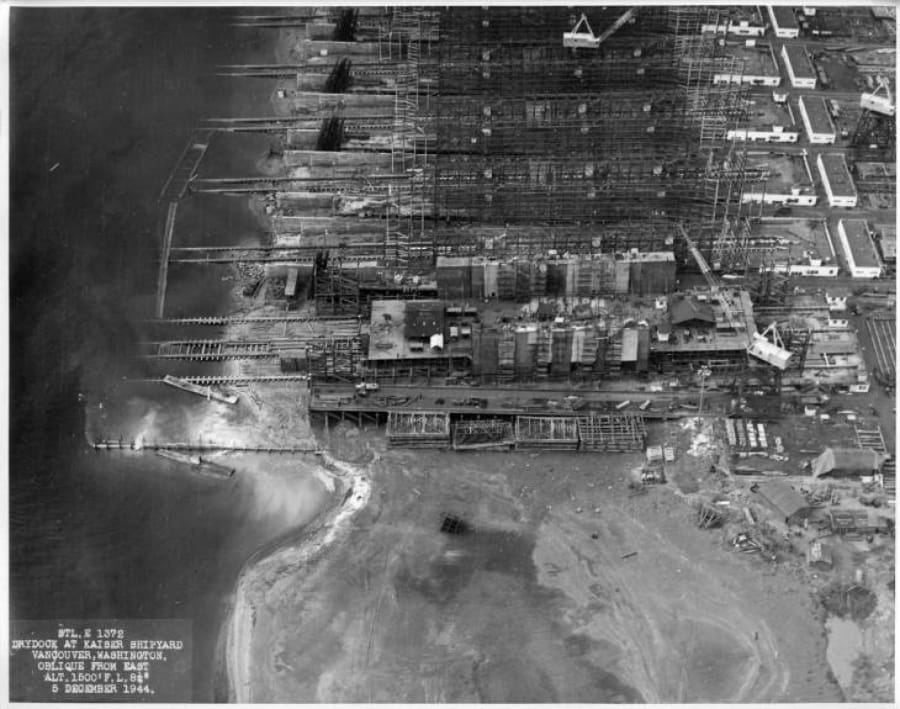Naomi Parker Fraley died in Longview last year. You may not know her by her full name, but you definitely know her by another one.
Fraley was likely the original inspiration for Rosie the Riveter, the World War II-era feminist icon who urged women to join the workforce when men shipped overseas in the 1940s. Rosie’s design — flexed arm, red bandana, emblazoned with “We Can Do It!” — became a defining image of the era.
But Fraley wasn’t the only local woman with a link to Rosie. Vancouver became ground zero for women entering the workforce during the war, as thousands flooded into the Kaiser Shipyard to take up work building ships for the U.S. Navy and transforming the city’s social and economic landscape.
At the start of the war, Vancouver was home to fewer than 20,000 people. By the 1950 census, the population had more than doubled. The Kaiser Shipyards had transformed the city, and the overhaul was largely driven by women.
Today, the number of local women alive to tell their stories of working at the shipyard is dwindling, much like the number of World War II veterans. But their histories are preserved in spoken interviews recorded at the Clark County Historical Museum.
One such personal history came from Lois Jemtegaard, who was born in Washougal in 1920 and interviewed by Serena Lawrence for the museum in 2010.
Jemtegaard recalled joining the Kaiser workforce in late 1943 or early 1944. At the time, she said, she had two children under the age of 5 at home, as well as a farm with cows and horses to tend to.
“Welding, it was mostly women. You know, housewives, like I had been,” Jemtegaard said.
“We felt like we did a double job because, you know, the farm at home and then down in the shipyards, but we got pretty rummy at times.”
Jemtegaard also recalled some tension in her newly gender-integrated workplace, though she said the men had to be supportive, otherwise “they would get in trouble, because they needed the women working there.” Her supervisors were all men, she added.
Despite that, Jemtegaard said, she’d been shocked to be “propositioned” by men from the East Coast. She’d stick with the women when she could, she added.
“There were only two women in the office, and I was the only woman on the outfitting dock on graveyard (shift). So I would take my lunch bucket and leave it with them, and eat lunch with them, ’cause I wasn’t going to eat with a bunch of men,” Jemtegaard said.
Her work was physical. Jemtegaard recalled hoisting heavy loads up and down stairs and ladders when she was transferred to the outfitting deck after being trained as a welder and machinist.
“You would have to take a lead over your shoulder and run down those stairs. We were young then! No heavy thighs, we just ran down there. We were young,” Jemtegaard said with a laugh.
‘Wives at the stag party’
A 1971 article in The Columbian, titled “Bustling ’yards’ said reminiscent of noisy beehive,” recounts how the Kaiser Shipyards employed women in droves as the military shipbuilding business started to take off.
Kaiser Co. signed a contract with the U.S. Maritime Commission for a new shipyard on Jan. 9, 1942, including a $100 million contract for 60 steel Liberty ships, which were used to haul a variety of cargoes.
As of May 1942, only 382 women — all office workers, such as receptionists — were employed at the Vancouver yard, the article states. Three months later, the company started recruiting women welders. All the crafts slowly started to accept women, and by November 1944, more than 10,000 women worked at the shipyards.
Weekly wages at the time averaged $60. The average employee also had $422 in government-issued War Bonds.
The article cites Mrs. Martin Jacobson, a Kaiser window washer, who said, “I’ve done housework and washed windows all my life, so it is nice to get a check every Thursday for doing the same that I’ve done for years anyway.”
One male worker said the phenomenon was “like taking your wife to a stag party.”
As workers poured into the area, resources became scarce. Work clothes were especially hard to come by, and women’s work shoes were hardest of all to find.
Bo’s’n’s Whistle, a glossy magazine published every two weeks by Henry Kaiser’s Oregon Shipbuilding Corporation, advised that “glamour was out,” encouraging women to pull their hair back, wear men’s jackets and skip the jewelry.
The simple, utilitarian fashion that arose earned Kaiser women a nod from Carmel Snow, then the editor-in-chief of Harper’s Bazaar, who called the women at the Vancouver yard among the “best dressed” in the world.
Jessie Del French, one of the women who worked on aircraft carriers in Vancouver in 1944, wrote that she felt a tremendous sense of satisfaction in her work.
“It was a wonderful and inspiring experience to see the ships completed,” she wrote. “The heighth (sic) and length of the carrier deck gave the impression of a temple dome in white.”
She’d go shopping in her work clothes, French wrote, and would occasionally be met with stares from other women.
“It was unusual for a woman of my age to be in heavy war work … it was easy to understand their envy, too. I had the feeling that I was doing something about Pearl Harbor in addition to remember that it had happened,” French wrote.
“To tell the truth I really pitied them. They had never gazed into the glass-domed beauty of a Sperry gyro-compass. None of them had ever seen a half dozen cannon move in unison with the swing of a man’s body. Nor had they ever viewed the intricate maze of piping whose hidden power could throw an airplane faster than a young man could throw a baseball.”
Hazel Stevenson, another Kaiser shipyard employee who worked as a tool checker, still has family living in Vancouver today.
Her great-niece, Laurie Kennedy, said her great-aunt Hazel lived in a trailer park on Fifth Street when she worked at the shipyards — one of many to move into temporary housing built to accommodate the influx of employees.
Stevenson died at 93 years old and was buried at Lincoln Memorial in Portland, Kennedy said. She has a picture of Rosie the Riveter on her headstone.




